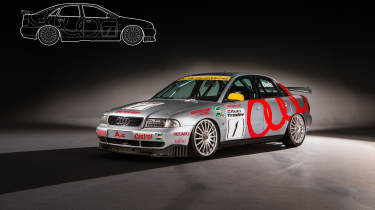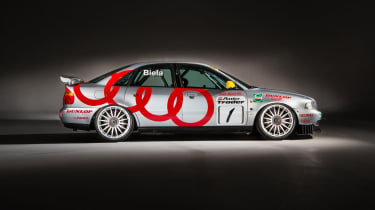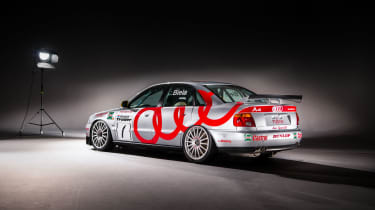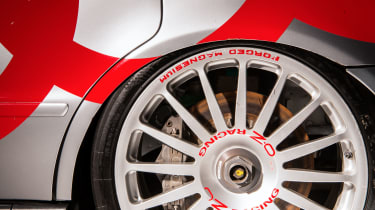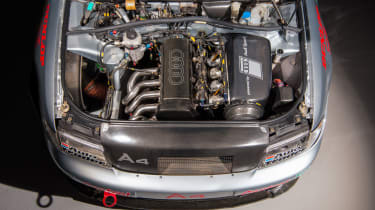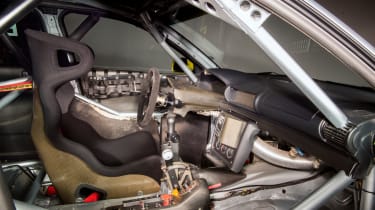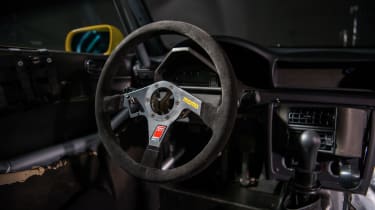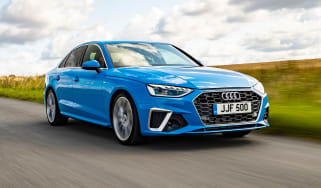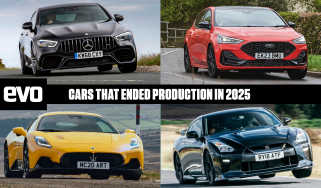Audi A4 Super Tourer: the anatomy of a Super Touring car
After the wild and expensive Group A era, the new 2-litre formula was launched. But it didn’t stay simple and affordable for long…
Whether you watched it from the sidelines at the time, caught the coverage on the telly, or are only now absorbing it from grainy YouTube videos, the Group A era of touring car racing was quite a sight: the Sierra Cosworth RS500s that dominated its later years were as dramatic and thunderous as you could hope for from a racing car.
But their death also spawned one of the most exciting formulae the motorsport world has ever seen. The 2-litre formula, or Super Touring as it became known, was a response to the spiralling costs of homologation and the changing needs of the car industry at the time. And when it ended little more than a decade later, its enduring appeal had been assured.
> Ford Sierra RS Cosworth – review, history, prices and specs
The 2-litre formula
The British Touring Car Championship was in full swing by the late 1980s, following its rebranding from the British Saloon Car Championship in 1987. Audiences were large, and the series enjoyed healthy coverage on the BBC’s Grandstand programme.
But a problem was brewing. The four-class system was confusing, with John Cleland winning the 1989 title in his Astra despite the RS500s dominating the overall race results. Also, the RS500 was nearing the end of its homologation period. When they exited, the series faced the prospect of just one or two Nissan Skyline GT-Rs – a relatively unknown car at the time – taking their place at the top.
The sport’s biggest players, including driver and team owner Andy Rouse and David Richards from Prodrive, proposed a 2-litre touring car formula. Engines would have no more than six cylinders, with drive sent to two wheels only. Turbocharging was suggested, but opposition from BMW nudged things in favour of natural aspiration.
There was an 8500rpm rev limit and, initially, standard engine mounting positions were used. The choice of unit remained fairly free, however, allowing for a motor from anywhere within the same manufacturer’s range to be fitted to a car, provided it complied with the 2-litre rule. ‘The cars cost a similar amount to build as those of the Group A era,’ explains Rouse, ‘but for manufacturers it was much cheaper as they didn’t have to specially homologate a car.’
The new formula ran alongside Group A in 1990, and on its own from ’91. Early participants included Toyota with its Carina – built by Rouse – as well as BMW, Nissan and Vauxhall, and the series grew fast. By 1992 Peugeot and Mazda joined the fray (with BMW replacing its 2-litre E30 M3 with the new E36 318is) and in 1993 Renault and Ford signed up.
Performance increased, too. ‘Initially I wasn’t that impressed as a driver,’ Rouse recalls. ‘Going from a 500bhp rear-wheel-drive car to a front-driver with less than 300bhp was a step down… But the cars had better brakes, they were lighter, and had more grip.’ It wasn’t long before they were achieving lap times better than those of the old Cosworths, and as the rules developed, the new cars became faster and more sophisticated still.
Alfa Romeo’s well-publicised dabble with adjustable aerodynamic devices in 1994 (spurred by a relatively low minimum homologation of 2500 cars, later raised to 25,000) opened the floodgates to full aero, which became legal in 1995. That same year the FIA – which had taken on the formula for the Touring Car World Cup in 1993 – adopted the term we’re familiar with today: Super Touring.
Audi A4 Super Tourer
Audi had been an early participant in 2-litre series throughout Europe with the 80 quattro, taking three consecutive drivers’ titles in the French and Italian championships, and scoring several victories in the ADAC Tourenwagen Cup in 1994 with Frank Biela at the wheel. With four-wheel drive permitted in the European series, progression to a quattro version of the new A4 for the 1995 season was a natural move, and the new car picked up where the 80 left off, securing the Italian title and taking more victories in the German and French touring car championships, against strong opposition from BMW and Peugeot.
> The anatomy of a Group B rally car
Dr Wolfgang Ullrich, then head of Audi Sport, made the decision in mid-1995 that the company should be represented in the British Touring Car Championship – a series rapidly developing a reputation for exciting racing and intense competition, with no fewer than nine factory entries that year. After several avenues had been explored, David Ingram and Richard Lloyd formed Audi Sport UK with the blessing of Audi UK. Like all of Audi’s touring car efforts, and indeed its motorsport activities to this day, the team would be run autonomously, but the cars themselves would be developed and built by Audi Sport at its base in Ingolstadt.
John Wickham was drafted in to manage the team, which for 1996 seconded the considerable driving talent of Biela, alongside newcomer John Bintcliffe, who had seen some success in single-make tin-tops. Crucially, the A4 would be allowed to keep its quattro all-wheel drive system for the BTCC.
Engine, suspension, body and aerodynamics
The A4 provided Audi Sport with some immediate benefits over the 80, including a shorter overall body length, longer wheelbase and wider tracks, as well as a shorter front overhang. Suspension was similar to the 80’s, with double wishbones at all four corners, while springs were provided by Eibach, dampers by Koni.
> Audi Quattro – review, history, prices and specs
Like its rivals, the A4 sported 8.2 x 19-inch forged magnesium wheels shod with tyres from Dunlop. The bodyshell required significant alterations to fit wheels of that size – plastic arch-liners marked the boundary between wheel wells and the engine compartment – and the resulting stance was an iconic part of the Super Touring era, with so little gap between tyre shoulder and arch lip that you’d struggle to slip a credit card between them.
The A4 was also aerodynamically efficient, and Audi Sport’s homologated aero package was extremely effective. Roger King, Biela’s race engineer during the 1996 and 1997 seasons, describes the A4’s aerodynamics as ‘perfect’, adding: ‘It reacted to the smallest changes – we’d notice a difference with a 3mm adjustment of the front splitter.’
The advanced aero helped overcome one of the car’s weaker areas: its engine. Based on the same in-line, 16-valve four-cylinder used in the 80, it was always underpowered next to the competition. ‘We were limited by the size of the valves compared with the cylinder bore,’ explains King, ‘and probably never made more than about 290bhp in 1996.’ While that’s more than the 255bhp being produced early on in 1993, Audi still lagged behind on power during its dominant season – Renault was making 300-plus bhp and Ford’s V6 was rumoured to put out over 310bhp.
Like other engines of the era, it still represented the peak of naturally aspirated tuning for the time, outfitted with individual 44mm slide throttle bodies fed by an enormous carbonfibre intake, upgraded with 85mm Mahle pistons and utilising dry-sump lubrication. Some sources quoted power as high as 296bhp at 8250rpm, and 188lb ft of torque at a screaming 7000rpm. In 1997, further modifications lifted power to around 316bhp – though some rivals were by then estimated to have more than 320bhp.
The position of the engine proved difficult too. As our images show, the four is mounted as far forward as it was in the road cars, a symptom of the all-wheel-drive layout. In contrast, it wasn’t unknown for rivals to fit their engines as low as possible and right against the cabin bulkhead. The Mondeo’s Mazda-sourced motor was famously mounted so low that the engineers ran the driveshafts through the V of the V6.
What the A4 lacked in straight-line speed it made up for in reliability and ease of use. The Audi Sport factory tightly controlled the development of the car throughout its life, and while this denied local squads the opportunity to change the car to suit national circuits (beyond suspension or differential settings), it meant no competitor could match the A4’s longevity.
> Read our review of the Audi RS4
‘We finished every single race in the 1996 season’ says King. ‘Not a single breakdown. It was our fundamental advantage, and the A4 was beautifully engineered – every component was “lifed”, so after a set mileage it would be changed regardless of condition.’ A suspension upright would last 3000km, engines would be rebuilt after two races.
The quattro system gave the A4 astonishing traction, braking stability and balance, though the engine layout did make it slightly nose-heavy, tending towards mild understeer. Drivers did experience oversteer at Snetterton’s dramatic Coram curve, but King says this was quickly dialled out with toe adjustments. Viscous front, centre and rear differentials allowed the team to vary the torque split, sending more power to the rear on circuits with faster corners and even running a locked rear diff where traction was a priority. Unlike its front-drive rivals, the Audi ran similarly sized brakes at both ends to take advantage of its even balance, with 343mm discs at the front, 330mm at the rear.
Biela has to take some credit for Audi’s 1996 dominance, too – his significant quattro experience made him a natural choice to lead the UK team’s BTCC charge.
‘Frank was a machine,’ recalls King. ‘We did some testing one weekend at Knockhill. We ran the car for eight hours, non-stop, and he just kept going.’ Biela was perhaps the perfect driver for the car: King tells of his ability to drive to 90-95 per cent of the car’s capabilities for lap after lap, but never over-driving like some of his contemporaries.
Biela’s experience with the car gave him an undoubted advantage over Bintcliffe, and King notes that while the A4 would naturally wear its front tyres a little more heavily, in-cockpit adjustment of the front and rear anti-roll bars meant the German ace would finish a race with perfectly equal wear levels all round.
Ultimately the A4’s disadvantages began to overwhelm its inherent benefits. It was hit with significant weight penalties from the start, carrying 95kg more than the 975kg front-drivers, and the amount of ballast grew further in 1997 until Audi decided it was being unfairly penalised. ‘In 1997, John Wickham finally went to [BTCC director] Alan Gow to contest our weight penalty,’ explains King, ‘and we scored five wins in the last five rounds.’ The organisers had given the A4 a 30kg respite and Biela finished the season second to Alain Menu’s Renault Laguna.
By the time all-wheel drive was banned in 1998, Audi had entirely lost its advantage. Biela had gone, and Yvan Muller scored the now front-drive A4’s best result that year with a second place at Knockhill. ‘We had so much weight over the front wheels in 1998 that the car would lift its rear tyres under braking,’ remarks King.
But the A4 had done its job. By the time it was retired in 1999, it had 15 global drivers’ championship victories to its name, taking seven in 1996 alone in Australia, Belgium, Germany, Great Britain, Italy, Spain and South Africa.
The fall of Super Touring
Super Touring lasted 11 years in the BTCC. What had started as an inclusive, uniform set of regulations to encourage manufacturers to compete had grown so sophisticated and expensive that few could stomach the budgets required to put their cars on the top step of the podium.
‘It started with Volvo,’ opines Rouse. ‘TWR discovered that they could mount their engine pretty much against the bulkhead, entirely behind the front axle, and everyone else followed. In 1995 Williams turned up with F1-scale resources and by the late ’90s Prodrive was re-engineering the cylinder heads of the [Ford] V6 at huge cost to convert them from direct-acting cams to rockers.’ Ford won the drivers’ title with Menu in 2000, but reportedly spent more than £10million on its three-car attack.
From a peak of ten factory-supported squads in 1994, participation fell to six teams by 1999. In 2000, Super Touring’s final year in the UK, just three manufacturer teams – Honda, Ford and Vauxhall, plus a handful of independents – made up the pack. So short on numbers was the series that grids had to be bolstered by over a dozen ‘Class B’ cars running to Super Production regs, similar to rallying’s Group N specifications.
It was out of this environment that the subsequent BTC regulations grew. The cars were slower, but the formula was much better at keeping costs in check. A typical BTC car cost under £100,000 to build, a third to a quarter of the cost of a late 2000s Super Tourer. This brought back some of the variety that had disappeared towards the end of Super Touring, with works teams from Vauxhall, MG, Peugeot, Honda and even Proton over the first few years.
By 2002, however, the writing was on the wall even for BTC, as the European Touring Car Championship debuted the FIA-sanctioned Super 2000 formula. The BTCC soldiered on with a mix of BTC and Super 2000 cars from 2004, and some BTC cars lasted until 2011 in the hands of privateers – the first year that the current Next Generation Touring Car (NGTC) cars hit the track. Standardised components and tight cost control mean NGTC will never have the mechanical intrigue we enjoyed in those glory years of Super Touring. Given all-wheel-drive remains illegal, it’s unlikely we’ll ever see dominance on the scale of Audi’s remarkable A4 Super Tourer, either.

